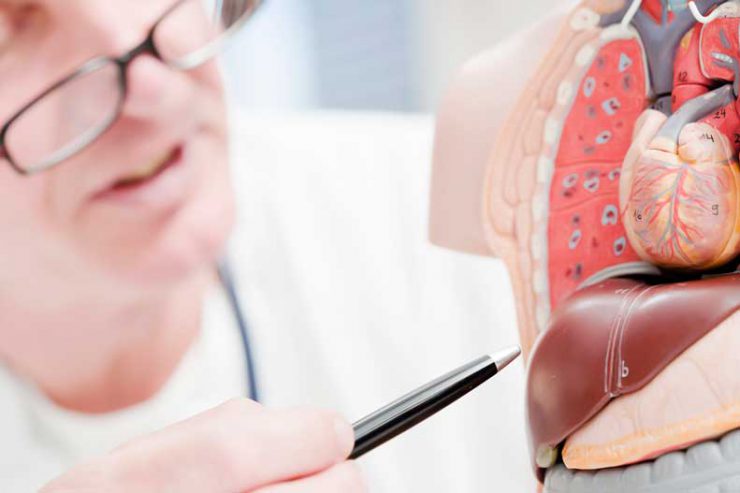The liver is one of the largest and most important organs in your body.
Found in your upper-right abdomen, just below your diaphragm, the liver performs more than 500 functions including:
- Processing nutrients.
- Breaking down fats.
- Storing vitamins.
- Metabolizing proteins.
- Breaking down old blood cells.
Your liver is so vital that you cannot live without it. But it is possible to live with only part of your liver. If your liver is failing, it may need to be partially or completely removed. A liver can even be transplanted completely or partially.
Liver Regeneration
The liver is the only organ in your body that can regenerate itself, or grow back, after damage or surgical removal.
While it seems hard to believe, your liver really can grow back to its full size and function in a few months.
Learn more about living-donor liver transplants at the UPMC Transplant Services website.
Never Miss a Beat!
Subscribe to Our HealthBeat Newsletter!
Thank you for subscribing!
You can now select the specific newsletters you'd like to receive.
You are already subscribed.
Subscribe to more newsletters in our email preference center.
Sorry, an error occurred. Please try again later.
Get Healthy Tips Sent to Your Phone!
Criteria for Liver Transplant
There are many conditions that can damage the liver and result in its need for removal. These are some common reasons a liver may need removed:
- Biliary atresia: A rare disease occurring in newborns that affects the liver and bile ducts.
- Viral hepatitis: Hepatitis B or C.
- Primary liver cancers: Cancerous tumors originating in the liver.
- Acute hepatic necrosis: Tissues of the liver that die as a result of infection from toxins, medications, drugs, or alcohol.
- Autoimmune hepatitis: The body’s own immune system attacks the liver.
See your health care provider if you are experiencing liver failure. Here you can find a list of liver diseases UPMC treats.
Living-Donor Liver Transplants
Because your liver grows back, you can donate a piece of your liver to someone else.
There’s a growing waiting list for liver transplants, but a shortage of deceased-donor organs. A living-donor liver transplant is a lifesaving option for someone in need of a new liver.
During a living-donor liver transplant, doctors remove a piece of your healthy liver. They then use it to replace the damaged liver of a recipient.
After surgery, your liver will regenerate back to its full size. The other person’s new liver will grow as well, leaving both people with healthy, functioning livers.
Living-donor liver transplants are possible for both adults and children.
How Much of My Liver Will Be Removed?
It depends on the size of the person you’re donating to.
It’s possible to remove between 25 to 65 percent of your liver and it will still grow back in a few months.
How to Become a Living Liver Donor
With more than 15,000 people waiting for a liver transplant, living-donor liver transplants save lives.
So, although you can’t live without your liver, you can share part of it with someone else in need.
To be a living liver donor, you must be:
- Between the ages of 18 and 55.
- In good general health.
In addition, you must have no history of:
- Liver disease, including cirrhosis, hepatitis B, and hepatitis C.
- Heart disease.
- Diabetes.
- HIV.
- Other diseases that could complicate the surgery, including some cancers and obesity.
The process of a liver transplant can seem daunting, but it has become a common surgery.
First the surgeons remove a portion of the donor’s liver through an incision in the stomach. The size and location of the portion taken is determined by what is needed for the replacement of the failing liver.
Surgeons then remove the failing liver and insert the portion of the healthy liver, connecting it to blood vessels and bile ducts.
The liver portions of both the donor and the recipient will regrow to normal liver function and volume in only a few months.
In most cases, a living-donor liver transplant has a higher success rate than a deceased-donor liver.
Get more details about living-donor liver transplants at UPMC.
Editor's Note: This article was originally published on , and was last reviewed on .
About Transplant Services
For more than four decades, UPMC Transplant Services has been a leader in organ transplantation. Our clinicians have performed more than 20,000 organ transplant procedures, making UPMC one of the foremost organ transplant centers in the world. We are home to some of the world’s foremost transplant experts and take on some of the most challenging cases. Through research, we have developed new therapies that provide our patients better outcomes — so organ recipients can enjoy better health with fewer restrictions. Above all, we are committed to providing compassionate, complete care that can change – and save – our patients’ lives. Visit our website to find a provider near you.
